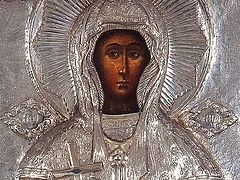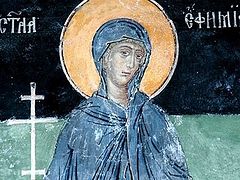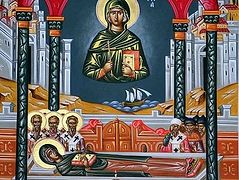In the third century of Christianity, when pagan rulers were putting Christians both young and old to torture and death for not bowing down to idols, there lived a young girl who was raised a Christian and who had true and steadfast faith. Hidden and praying to the True God in a house church with forty-eight other Christians, while pagans worshipped demons, was the maiden Euphemia, the daughter of a senator. When the civil authorities discovered these young Christians, they were taken to the tribunal. All of the children were tortured for nineteen days and finally put to death by the Emperor Diocletian, but none waivered in their faith. The noble Euphemia was singled out for special treatment by the governor of Chalcedon.
Euphemia prayed to the Lord Jesus Christ, Who strengthened her in her coming ordeal. First the governor flattered her and tried to bribe her with promises of rank and riches. But the young girl preferred her Lord Jesus Christ above all.
Sharp knives, red-hot ovens, hidden pits with spears, and wild beasts could not harm the maiden who was wholly devoted to Christ. Only at the saint’s prayers that she die a violent death did the Lord finally allow a she-bear to bite her in the leg, at which she gave up her pure soul. The guards would not have given Euphemia’s body for Christian burial, but the Lord sent an earthquake at which they all fled. Thus were her parents able to take up her holy body and bury it not far from Chalcedon. She died in the year 304, and is commemorated on this day, September 16/29.
In Chalcedon a majestic church was built over St. Euphemia’s relics. In the year 451 there was a famous Council held in that city, which would go down in history as the Fourth Ecumenical Council. The Orthodox world was in a state of great discord. Many people believed in the Monophysite heresy, and while many did not, the exact reason why they could not believe in it had to be precisely expressed as dogma. For a long time, representatives of each side made their own arguments, and could not reach an agreement. Then the Patriarch of Constantinople came up with an idea that we will scarcely see expressed today: to leave the decision up to the Holy Spirit. But how does one do that? How do we ask the Holy Spirit? The Council members had a solution that was obvious to them, located as they were in the church that contained the wonder-working relics of St. Euphemia. Each side wrote its confession down on its own scrolls and placed them on her relics. In the presence of the Emperor, the tomb was sealed with the imperial seal and a watch was set for three days. Both sides prayed and fasted very strictly for those three days, and when the tomb was opened it was seen by all that St. Euphemia was holding the scroll of the Orthodox in her right hand, and the scroll of the Monophysites lay at her feet. She even raised her hand to give the Orthodox scroll to the patriarch.
This obvious sign was accepted by the wavering as proof of the rightness of Orthodox dogma. But those who had put so much stock in the Monophysite heresy did not give in! They could not be convinced, no matter what miracles they saw.
We celebrate this event every year on July 11/24, and St. Euphemia is now called by the Orthodox, “The All-Praised”. It is a wondrous miracle for the saint to have presented God’s answer to the Council. But just stop and think about how wondrous our holy Orthodox hierarchs and clergy of this Council were. Certainly there were many very well-educated, erudite scholars present among the 630 representatives of that Council. There were patriarchs among them who were held in great authority. The Emperor himself could have taken the side of the Constantinople Patriarchate against that of Alexandria out of patriotic support for the capital city, and simply forced everyone to follow this dogma. Let’s not forget that this has actually happened in history—just recall the Emperor Charlemagne and all the trouble he caused with his despotic political theologies—trouble that goes on to this day.
But no, that is not how it was among those holy men. They did not ask for a final solution from the Emperor, or the theologians, or any individual patriarch. They turned to a martyr, a young virgin, for they knew that our Lord Jesus Christ, the Head of our Church, stood behind, blessed, and supported that young girl through frightful sufferings, and that she was faithful to Him throughout her ordeal. No bribes, no flattery, no threats could shake her faith and devotion to Him. Just imagine what it would have been like for a young girl to face a rotating wheel with sharp blades designed to rip her flesh to shreds, or a red-hot oven that would burn her alive, or wild beasts that were supposed to gnaw her body in front of a crowd. For many, the raging fury of a governor would be enough to paralyze one with fear. But here in the church were her holy, incorrupt relics to prove that Christ triumphed in this weak young maiden. Thus, the holy men were certain that if they prayed and fasted—that is, approached the matter with all seriousness and religious earnestness—God would speak through His faithful sufferer.
This amazing example lives on. Throughout the history of the Church, there have been false teachings, and false hierarchs who will listen to no one and are determined, for one reason or another, to carry on in their error. Moreover they have taken entire geographical populations along with them. They followed teachings that they and their advisors devised, but did not believe God’s sign when it was right before their eyes. This is what pride leads men to do. But the wise men whose decision the Orthodox follow to this day humbled themselves before a young girl-martyr, because the suffering Church has always been the Church that shows itself to be faithful to Christ. The Church has always been tested by suffering, and those who are willing to suffer receive help from Christ to bear it. Christ’s victory in them has always been a sign to all. “The martyrs’ blood is the seed of the Church.”
Take, for example, the phenomenon of the “Living Church” in the Soviet Union. At the turn of the twentieth century, there were a number of clergymen in Russia who got caught up in the revolutionary mindset that was fomenting in Russia. They felt that in the tectonic shifting of their country’s politics they might be able to introduce new ideas into Orthodoxy as well—Church “reforms”. Because their ideas were worldly and inspired by politics, they became the tool of the new soviet regime, whose ultimate goal was not reform, but annihilation of the Church. Lenin even devised a twisted negative PR to this end: The less upright, the more compromised the clergy, the better for the soviet government. Therefore, the soviet government chose to back what then took form as the “Living Church”, and declare it the only legal Orthodox Church in the nation. The “Orthodox Church in the USSR”, as they called themselves, had as their goal, “the democratization of Church governance and modernization of Church services.” The leading “hierarch” of this “church” was Alexander Vvedensky, who as a “hierarch” continued to live in a conjugal state with his wife. Naturally, one thing on his agenda was a release of the age-old rule in the Orthodox Church that bishops cannot be married.
The lawful Patriarch Tikhon, who had been chosen at the Local Council held in 1918 where representatives of the totality of the Russian Orthodox Church, of the clergy, monastics, and laity were present, did not accept this schismatic development. He refused to meet with its bishops and clergy, unless it be to accept their repentance. His flock stood firmly behind him, while the soviet government stood behind the Renovationists. Here are a few of the "Living Church's" intended renovations:
-
Permission for monastics (including bishops) to marry, while retaining their episcopal and clerical ranks;
-
Permission for the clergy to marry after their ordination, to remarry or to marry widows;
-
Permission for the married priests to be consecrated as bishops.
It is interesting how these items always seem to come to the fore when renovationist movements start to gain momentum.
Monasticism has often been called a “bloodless martyrdom”. One could say that part of this martyrdom is that they may have to suffer a little by not being married. Our bishops have always been monks, so that wives, children, and so on would not hinder them from rightly ruling their dioceses. They have to suffer a little in this life, because they do not have the comfort that a housewife can provide.
We do have a married priesthood. But it has always been our canonical practice that candidates for the priesthood be married before they are ordained, so that their own house be in order before they take up the cross of serving the spiritual needs of a parish. When a priest’s wife dies (or if she should divorce him), the priest, if he wants to continue to be a priest, is to remain a widow, and not cause his parishioners any temptation by marrying again. The widowed priests have to suffer a little.
But this has always been known to those who are deemed worthy of the priesthood or a bishopric, and no one has ever been forced into ordination. Monks are made bishops often as part of their monastic obedience; but again, the monastic tonsure itself, with its vow of obedience, is voluntary. Anyone who renounces his priesthood or monastic vows—well, God forbid that we should appoint ourselves judges over them. But our Church has provided for a limitation on their service in the Church, for their own good and the good of the faithful.
We all as Christians have to bear our own cross, which means bearing suffering—be it physical martyrdom, or the sacrifice of our own desires for the sake of our Lord Jesus Christ, Who always helps us in this struggle.
As for the Church crisis in the early Soviet Union—many of the Russian Orthodox clergy followed the Renovationists, first out of their desire for reforms, and later out of the desire to remain alive and out of prison. We know by hindsight that the Renovationist movement crashed while the canonical Church remained, but certainly at the time it was not so clear what to do. However, the vast majority of the faithful remained with their true pastor, whose voice they knew. The Living Church parishes were empty, while the churches that stayed with Patriarch Tikhon and his successors were full. The faithful were ready to suffer—in the least by being “illegal” from the atheist government’s point of view, and at worst by being tortured and imprisoned for their faith. They knew the voice of their true shepherd, who did not resign and leave them to the wolves. They knew his voice because they knew the voice of Christ, by practicing their Orthodox faith in spirit and in truth. Orthodoxy with its holy traditions lived on in the lives of its devoted children. In the end, even many of those who followed the Renovationists were imprisoned and put to death by the very government that had given them the legal right to take over the churches of the canonical Church.
The history of our holy, beloved Church, the Lives of its saints, and the writings of its holy venerable fathers are available for us to study. These writings help us to know what is right and what is wrong, and what we should do when things become very confusing. But Christ told us that the gates of hell will not prevail against our Church. And He also told us that we are to render unto Caesar the things that are Caesar’s, but to God the things that are God’s. Those who are with God know when the time has come to suffer, and if God blesses, they will have the strength to suffer. And our holy hierarchs of the Fourth Ecumenical Council left us a brilliant example to follow: that suffering for Christ is our spiritual compass, and a pure, virgin martyr whose soul is with Christ is more to be trusted than hundreds of clerical scholars.






